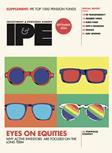ESG Special Reports – Page 7
-
Special Report
Net Zero and Just Transition for Pension Funds
The Conference of the Parties (COP) 26 in Glasgow represents a new milestone in the global fight against climate change, with a more climate-friendly US administration and growing mobilisation in favour of “Net Zero”. Six years on from the Paris agreement, the objective is clear: limiting temperature rise to well below 2°C above pre-industrial averages, which means reaching net-zero carbon emissions by 2050, and halving them by 2030.
-
 Special Report
Special ReportThe global race to net zero
Leading global asset managers aiming to achieve net zero greenhouse gas emissions by 2050
-
 Special Report
Special ReportWhat makes an “impact” investment manager?
Understanding the required foundation to build, manage, and measure an impact portfolio.
-
 Special Report
Special ReportInsurance Linked Securities: developing climate resilience
Insurance Linked Securities (ILS) are an alternative asset class where investors’ returns are primarily linked to the occurrence of natural catastrophes. Since the majority of exposures emanate from climate-related risks, the potential impact of climate change is a key consideration for ILS managers and investors. In parallel, ILS is receiving increased recognition for its inherent ESG-positive characteristics with the critical role insurance plays in helping society develop long-term resilience.
-
 Special Report
Special ReportUnravelling the conflicts in ‘Double Materiality’
Where do you draw the ‘moral’ line and how do you have a genuinely positive impact?
-

-
 Special Report
Special ReportLong-term investors absolutely cannot afford to function without a Climate lens (and why that may not be enough)
Sponsored Commentary from Morgan Stanley
-
 Special Report
Special ReportThe wheat and the chaff: Man Group’s case study in rating an RI Fund
As responsible investing becomes default best practice, it is increasingly important that allocators can separate the wheat from the chaff, distinguishing genuine responsible investment managers from those that greenwash. Below, we provide a case study that sets out the best practices for allocators.
-
 Special Report
Special ReportTurning Net Zero pledges into action
In the run-up to COP26, Net Zero pledges have become increasingly ubiquitous. Over 100 countries, including China, the U.S. and the EU, have pledged to become Net Zero. Further, over 100 local governments, nearly 1000 cities and 20003 businesses pledged to operate at Net Zero. Net Zero is now also the trillion dollar challenge for investors. The Net Zero Asset Owner Alliance and the Net Zero Investment Framework have embarked to build Net Zero portfolios.
-
 Special Report
Special ReportGlobal poverty and the role businesses can play to help put an end to it
The Sustainable Development Goals (SDGs) are a blueprint for a better and more sustainable future for all. It is therefore right that the first of them is to “end poverty in all its forms everywhere”. However, the onset of the Covid-19 global pandemic has dealt a big blow to this aim, with global poverty increasing last year for the first time in decades.
-
Special Report
Heterogeneity: the key to good business management
Diversity and inclusion benefit companies and investments in the long term. This is the conclusion from various reports published over the last year by training institutes and financial-consulting companies. Information and research form the basis for analysis and screening tools to enable a financial model that Etica has always believed in: a sustainable, ethical and inclusive economic system.
-
 Special Report
Special ReportAn actor for change
The Edmond de Rothschild Group, whose roots date back 250 years, is committed to supporting the major changes that shape our society, with the conviction that investment must be built over time and have an impact on the real economy. Our independence gives us the freedom to express our convictions, reflected in our voting policy and our leading engagement approach.
-
 Special Report
Special ReportFrom climate change to biodiversity, and vice-versa
In addition to taking note of the extent of the climate crisis, successive IPCC reports have stressed that carbon neutrality must be achieved while protecting biodiversity. Indeed, half of the CO2 emissions generated from human activity are captured by land- and sea-based organisms, which absorb about 9.5 billion tonnes of CO2 each year. Preserving, sustainably managing, and restoring ecosystems can thus contribute to decarbonisation efforts.
-
 Special Report
Special ReportHow can the investment industry address the biodiversity crisis?
It’s never been more important for the financial sector, including the investment industry, to take steps to help safeguard the planet’s threatened biodiversity. ESG analyst at BNP Paribas Asset Management, Robert-Alexandre Poujade explores the areas in which investors can make a difference.
-
 Special Report
Special ReportInvesting in the blue economy
Better ocean health is vital for addressing climate change. As fixed income investors, we’re seeing growing opportunities to make a difference.
-
 Special Report
Special ReportSix best practices for carbon offsets
As investors and companies increasingly seek to address the risks of climate change, there is growing debate about the use of carbon offsets in achieving net-zero emissions. We think there’s room for a measure of offsets to achieve carbon neutrality, provided best-practices are followed.
-
 Special Report
Special ReportClimate change risk metrics: The rising tide
The industry is now seeing an expansion in data-driven practices, with new climate datasets emerging and becoming mainstream. Climate change itself is a phenomenon comprised of many interlinked processes, each with their own risks and uncertainties. To cater to the growing demand for quantitative climate change risk metrics, vendors have begun to explicitly model climate change risk.
-
Special Report
Impact investing as a way to support the transition to a low carbon economy
The transition to a low carbon economy requires political will, a carrot-and-stick approach and the investment of significant resources. The public sector won’t be able to finance the transition alone. Governments shall continue to support market investments in companies and technologies providing solutions to environmental problems. We identify some attractive investment opportunities for impact investing.
-
 Special Report
Special ReportMaking sense of ESG Data: How to Quantify SDG Contribution
Sustainability is one of the world’s most prevalent topics, and within asset management investors are accordingly shifting their portfolios towards environmental, social and corporate governance (ESG) investing. As a result of this increased demand for ESG investing, various frameworks have emerged such as ESG rating, ESG metrics and Sustainable Development Goal (SDG) impact. These frameworks are defined by a vast amount of data and specific methodologies in order to measure the exposure. This poses a challenge for investors due to the necessity to understand the complexity of sustainability while also dealing with the quantity of available data.
-
 Special Report
Special ReportPGIM Fixed Income case study— filtering Asian Green Bonds through our framework
Issuers have myriad incentives—often including a lower cost of capital than a traditional bond—to apply the green label to their bond offerings. Yet, once filtered through our Green Bond Framework, it’s clear that many of these securities present the opportunity for only marginal environmental improvements or possibly none at all. Although this less-than-green issuance has occurred globally, it has become prominent in Asia as the size of the green bond market has grown and issuers’ ESG initiatives have continued to evolve from their early stages.





